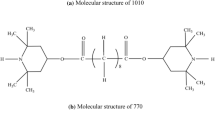Abstract
In this study, the effects of phenolic resin (PF) on the permanent deformation and short-term aging resistance of SBR-modified asphalt binder were investigated. Multiple stress creep recovery (MSCR) tests, Fourier transform infrared spectroscopy (FTIR), and gel permeation chromatography (GPC) were performed to investigate the effect of PF on the deformation resistance and aging resistance of SBR-modified asphalt with PF (S4P3). The results show that PF can significantly improve the permanent deformation resistance and aging resistance of the asphalt binder. In addition, S4P3 showed different molecular weight changes during the aging process, and the percentage of large molecular size (LMS) in asphalt has a significant impact on the deformation recovery ability and temperature sensitivity of asphalt.
Similar content being viewed by others
References
Y. Becker, M.P. Mendez, Y. Rodriguez, Polymer modified asphalt, Vision tecnologica, Citeseer, PA, USA, 2001.
R. Bates, R. Worch, Engineering Brief No. 39, Styrene-butadiene rubber latex modified asphalt, Federal Aviation Administration, Washington DC, USA, 1987.
G. King, H. King, R. Pavlovich, A.L. Epps, P. Kandhal, Additives in asphalt, J. Assoc. Asphalt Paving Technol. 68 (1999), 32–69.
Y. Cong, K. Liao, W. Huang, Y. Zhai, Performance of SBR-modified asphalt Yufeng Cong, Petrol. Sci. Technol. 24 (10) (2006), 1187–1194.
C. Zhu, H. Zhang, G. Xu, C. Shi, Aging rheological characteristics of SBR modified asphalt with multidimensional nanomaterials, Constr. Buil. Mater. 151 (2017), 388–393.
F. Zhang, J. Yu, The research for high-performance SBR compound modified asphalt, Constr. Buil. Mater. 24 (3) (2010), 410–418.
F. Zhang, C. Hu, The research for SBS and SBR compound modified asphalts with polyphosphoric acid and sulfur, Constr. Buil. Mater. 43 (2013), 461–468.
B. Zhang, M. Xi, D. Zhang, H. Zhang, B. Zhang, The effect of styrene-butadiene-rubber/montmorillonite modification on the characteristics and properties of asphalt, Constr. Buil. Mater. 23 (10) (2009), 3112–3117.
J. Zhang, J. Wang, Y. Wu, W. Sun, Y. Wang, Investigation on thermo-rheological properties and stability of SBR modified asphalts containing palygorskite clay, J. applied Polym. Sci. 113 (4) (2009), 2524–2535.
P. Liang, M. Liang, W. Fan, Y. Zhang, C. Qian, S. Ren, Improving thermo-rheological behavior and compatibility of SBR modified asphalt by addition of polyphosphoric acid (PPA), Constr. Buil. Mater. 139 (2017), 183–192.
Y. Li, P. Cheng, E.A. Siddig, C. Han, Investigation on thermal aging stability of crosslinked styrene butadiene rubber modified asphalt binder, Road Mater. Pavement Des. (2019) https://doi.org/10.1080/14680629.2019.1574234
A. Shojaei, M. Faghihi, Physico-mechanical properties and thermal stability of thermoset nanocomposites based on styrene-butadiene rubber/phenolic resin blend, Mater. Sci. Eng. A 527 (4–5) (2010) 917–926.
B. Derakhshandeh, A. Shojaei, M. Faghihi, Effects of rubber curing ingredients and phenolic-resin on mechanical, thermal, and morphological characteristics of rubber/phenolic-resin blends, Journal of Applied Polymer Science 108 (6) (2008), 3808–3821.
L.Y. Ming, C.P. Feng, E.A. Siddig, Effect of phenolic resin on the performance of the styrene-butadiene rubber modified asphalt, Constr. Buil. Mater. 181 (2018), 465–473.
N. Tang, W. Huang, High temperature performance evaluation and grading of SBS modified asphalt based on multiple stress creep recovery test, Journal of Building Materials 19 (2016), 665–671.
Z.-g. Feng, S.-j. Wang, H.-j. Bian, Q.-l. Guo, X.-j. Li, FTIR and rheology analysis of aging on different ultraviolet absorber modified bitumens, Constr. Buil. Mater. 115 (2016), 48–53.
J. Lamontagne, P. Dumas, V. Mouillet, J. Kister, Comparison by Fourier transform infrared (FTIR) spectroscopy of different ageing techniques: application to road bitumens, Fuel 80(4) (2001) 483–488.
P. Cong, B. Chen, H. Zhao, Coupling effects of wasted cooking oil and antioxidant on aging of asphalt binders, Inter. J. Pavement Res. Technol. 13 (1) (2020), 64–74.
X. Feng, W. Chen, W. Li, Effects of silane coupling agent modified coal waste powder on performance of asphalt mortar and asphalt mixture, Inter. J. Pavement Res. Technol. 13 (4) (2020), 383–391.
J. Shen, S.N. Amirkhanian, S.-J. Lee, HP-GPC characterization of rejuvenated aged CRM binders, J. Mater. Sci. Eng. 19 (6) (2007), 515–522.
K.W. Kim, J.L. Burati Jr, J.-S. Park, Methodology for defining LMS portion in asphalt chromatogram, J. Mater. Sci. Eng. 7 (1) (1995), 31–40.
N.W. Garrick, Use of gel-permeation chromatography in predicting properties of asphalt, J. Mater. Sci. Eng. 6 (3) (1994), 376–389.
S. Zhao, B. Bowers, B. Huang, X. Shu, Characterizing rheological properties of binder and blending efficiency of asphalt paving mixtures containing RAS through GPC, J. Mater. Sci. Eng. 26 (5) (2014), 941–946.
Acknowledgments
The authors would like to thank the China Scholarship Council (CSC) for the financial support, which was provided to support the study at Queen’s University. Yiming Li would also like to thank Professor Simon Hesp of Queen’s University for his support and guidance.
Author information
Authors and Affiliations
Corresponding authors
Additional information
Conflict of interest
No conflict of interest was reported by the authors.
Peer review under responsibility of Chinese Society of Pavement Engineering.
Rights and permissions
About this article
Cite this article
Cheng, P., Li, Y. & Zhang, Z. Effect of phenolic resin on the rheological, chemical, and aging properties of SBR-modified asphalt. Int. J. Pavement Res. Technol. 14, 421–427 (2021). https://doi.org/10.1007/s42947-020-0159-0
Received:
Revised:
Accepted:
Published:
Issue Date:
DOI: https://doi.org/10.1007/s42947-020-0159-0




